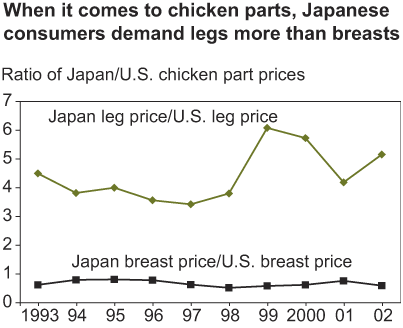Differences in Demand Help Shape Meat Trade
- by John Dyck and Ken Nelson
- 9/1/2003
At a value of over $40 billion (10 percent of global agricultural trade) and a volume of 20 million tons per year, global trade in meats is big business. Growing populations, rising incomes, and increased urbanization have all contributed to a boost in demand for meat. This demand has been supplied, in part, by low-cost meat from countries with good resources for meat production, such as abundant feedgrains. But other factors, such as numerous import tariffs and sanitary rules safeguarding the health of animals and humans, affect meat trade as well. Yet another dimension to global meat trade is differences in demand for meat cuts.
Most meat trade is in the form of cuts. One cut, or part, of a slaughtered animal can be shipped to one place while other parts are sent elsewhere. Demand for the parts varies considerably, both within and among countries, depending on consumer tastes, whether cuts can be substituted for one another, and other factors. In the U.S., for example, consumers prefer beef steak to beef liver. Despite the greater abundance of steak meat (a steer yields about 16 times more steak than liver), the U.S. price of steak is much higher than that of liver. Chicken legs are prized in some countries but get a low price in others. Chicken legs are 4-5 times as expensive in Japan as in the U.S., but chicken breasts cost 25-40 percent less in Japan. The price differences reflect consumers’ willingness to pay for these cuts.
Some trade seems to reflect these differences in demand, rather than competitiveness in producing the meat. For example, it is uncertain whether chicken and hog production costs less in the U.S. than in China. The large U.S. exports to China do correspond to demand for different cuts, however. The main U.S. chicken exports to China are feet, wings, and legs, while the main pork exports are organs, such as hearts.
The ability to mix and match cuts for different markets offers meat firms the opportunity to send each part of an animal to the market that will pay the highest price for it, thereby increasing the aggregate value of each animal. If lower tariffs or increased success in meeting sanitary standards allow meat trade among more countries in the future, trade in cuts is likely to proliferate as firms find higher valued matches for various cuts.
This article is drawn from:
- Dyck, J. & Nelson, K. (2003). Structure of the Global Markets for Meat. U.S. Department of Agriculture, Economic Research Service. AIB-785.


